Pulmonary fibrosis is a chronic, progressive disease characterized by abnormal thickening of lung tissue, severely impairing breathing. Current therapies are limited: they can only slow progression but do not address the root cause.
A new approach using extracellular vesicles (EVs) derived from umbilical cord mesenchymal stem cells (hUC-MSC-EVs) administered via nebulization offers promising prospects for more effective and targeted treatments.
An Innovative and Safe Approach
A phase I clinical trial, published on June 4, 2025 by Meng Li and colleagues, demonstrated the safety and therapeutic potential of hUC-MSC-EVs in patients with pulmonary fibrosis.
Nebulization delivers EVs directly to the lungs, maximizing local efficacy and minimizing systemic effects.
-
Treatment protocol: twice daily nebulizations for 7 days, in addition to standard therapy.
-
Results: significant improvements in lung function (forced vital capacity and maximum voluntary ventilation), quality of life (SGRQ and LCQ scores), and oxygen saturation.
-
Safety: no serious adverse events; no signs of liver, kidney, or inflammatory toxicity.
What Are hUC-MSC-EVs?
EVs are naturally released microparticles carrying microRNAs, proteins, and metabolites.
Those used in this study were derived from umbilical cord stem cells, known for their anti-inflammatory and regenerative properties.
-
Advanced analyses identified over 1,400 microRNA types, many linked to cell cycle regulation, immune response, and tissue repair.
-
Structural proteins and key metabolites suggest an active role in modulating the fibrotic lung environment.
Preclinical Evidence
In mouse models of bleomycin-induced pulmonary fibrosis, nebulized EVs:
-
reduced mortality (from 20% to 80%),
-
restored lung volume,
-
reduced inflammation,
-
improved oxygenation.
Micro-CT imaging revealed structural lung regeneration, with regression of fibrotic lesions.
Immunological analyses showed a shift of macrophages toward the anti-inflammatory M2 phenotype and upregulation of anti-fibrotic genes (IL-10, HGF, MMP13), while pro-fibrotic markers (SPP1) were reduced.
GMP-Standard Production
EVs were produced under GMP conditions with strict quality controls.
Their integrity and biological activity were preserved even after nebulization, ensuring stability and reproducibility—key requirements for future clinical scalability.
Clinical Implications
Although patient numbers were small, results are encouraging: in two cases of advanced post-inflammatory fibrosis, HRCT scans showed visible regression of fibrotic lesions.
This suggests nebulized hUC-MSC-EVs could become a complementary therapy, especially for fibrosis secondary to inflammatory processes.
Conclusion
Nebulized EVs from umbilical cord stem cells represent a potential breakthrough in regenerative medicine for pulmonary fibrosis.
The study by Meng Li et al. confirms their safety and highlights promising efficacy, paving the way for new clinical trials and future therapeutic use.
Reference
Meng Li et al. Clinical investigation on nebulized human umbilical cord MSC-derived extracellular vesicles for pulmonary fibrosis treatment.
Signal Transduction and Targeted Therapy, 2025 Jun 4;10:179. doi: 10.1038/s41392-025-02262-3


